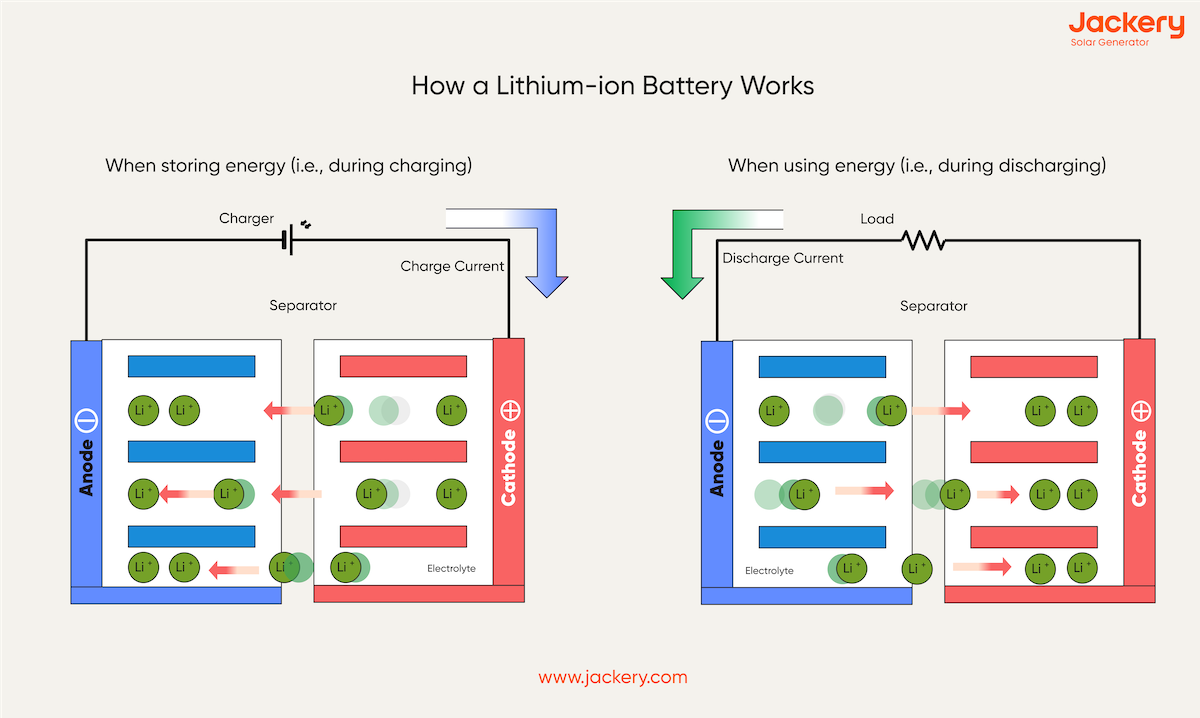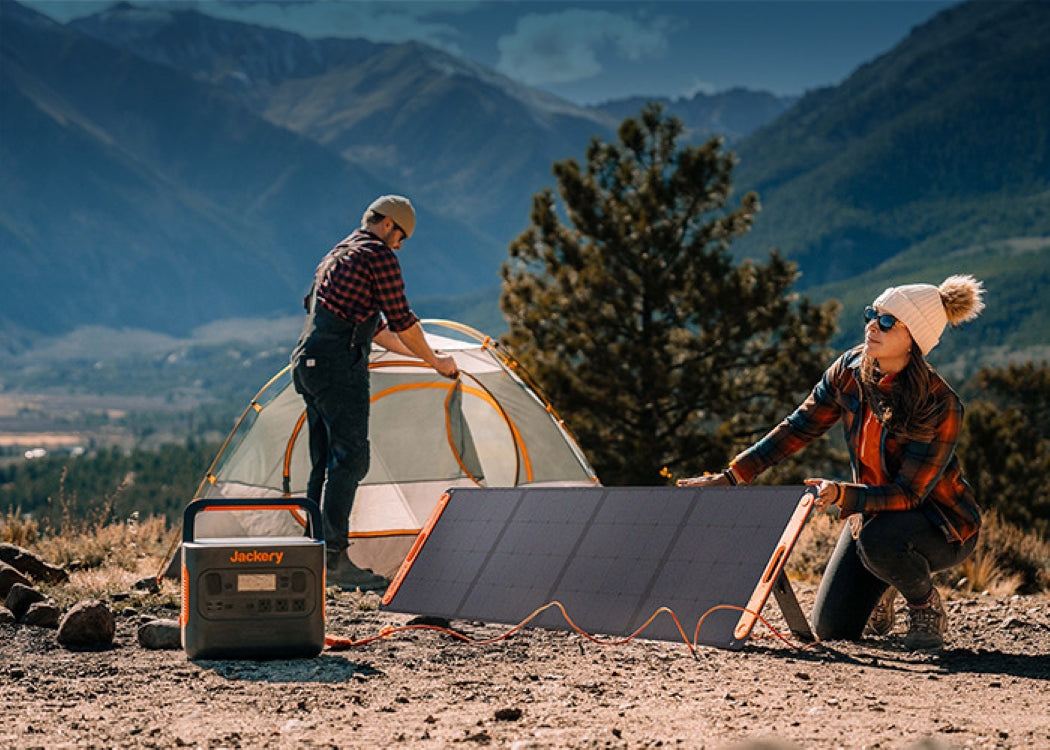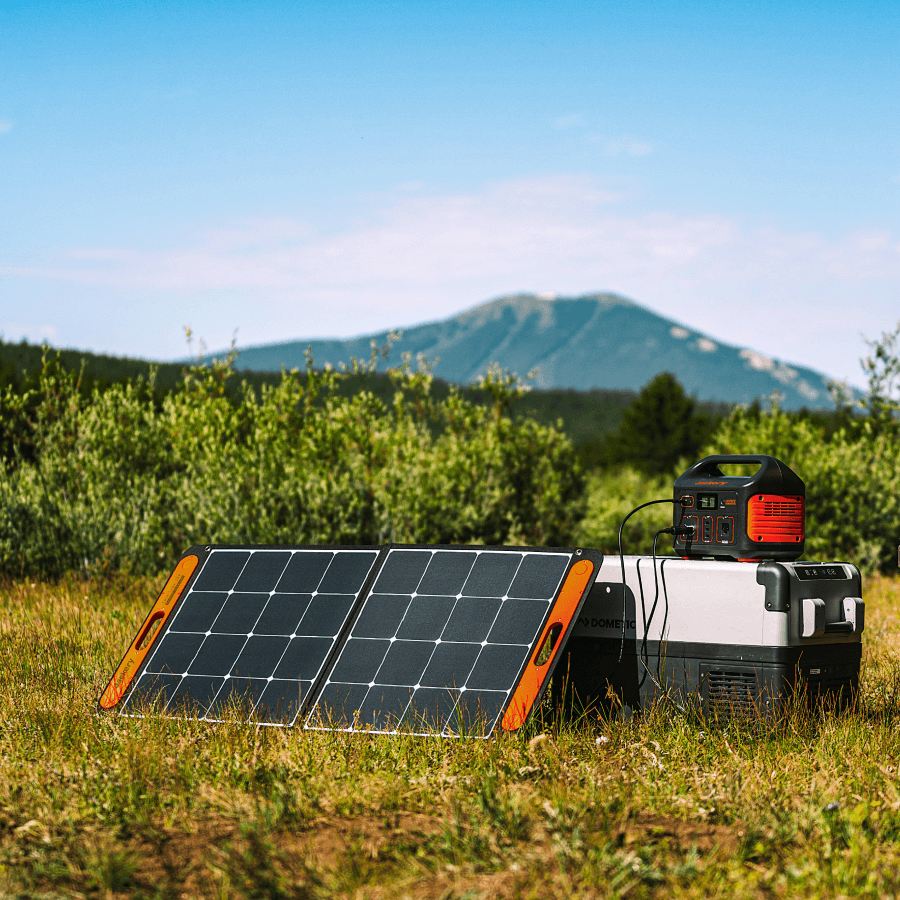Lithium-ion batteries are present in most of the electronic devices, like smartphones, laptops, and even solar power systems. When purchasing any appliance or battery backup, you'll need to keep the battery life in mind. But how long do lithium batteries last? The lifespan of the Li battery will depend on the number of charging cycles they undergo and how well they are maintained.
For instance, the Jackery Explorer 3000 Pro Portable Power Station has a long cycle life of around 2000 cycles, after which the battery will still have over 70% capacity. Similarly, the Jackery Explorer 2000 Plus Portable Power Station has a capacity of 2042.8Wh and a lifespan of around 4000 cycles, after which it will still have 70% of its capacity. Here are different Jackery Explorer Portable Power Stations and their technical specifications.
What Are Lithium-Ion Batteries?
Lithium-ion batteries are popular rechargeable battery chemistry that powers the devices we use every day. They consist of single or multiple Li-ion cells with a protective circuit board. Here are the components of lithium-ion batteries:
- Electrodes: The lithium-ion cell has two electrodes at the ends called anode (negative electrode) and cathode (positive electrode).
- Electrolyte: It is the gel or liquid responsible for conducting electricity.
- Separator: It is the porous polymeric film separating the electrodes while offering the exchange of Li-ions from one side to the other.
- Current Collectors: These are the conductive foils at each electrode connected to the cell terminals.

Lithium-ion batteries provide many benefits over other types, including higher efficiency, longer lifespan, high energy density, and lightweight nature.
How Long Do Lithium-Ion Batteries Last?
Most standard lithium-ion batteries have an expected lifespan of nearly 500 cycles. On average, it can last somewhere between 2-3 years, depending on how often you use them. The lifespan of standard Li-ion batteries can be extended to 5 years if they are maintained well. When the lithium ions travel between the anode and cathode through the electrolyte, the energy is stored and released in the battery.
While charging the lithium-ion battery, the positive Li-ions move from the cathode terminal to the anode. The potential difference between these two electrodes charges the battery. Similarly, when the lithium-ion stored in the anode moves to the cathode, the energy is used, and it discharges the battery.

Jackery offers high-quality NMC and LiFePO4 batteries that are designed to last longer and be more efficient. The wide range of battery capacities and sizes makes them ideal for outdoor adventures and off-grid power. For example, the Jackery Explorer 3000 Pro is rated for 2000 cycles. Once it completes these full cycles, the battery will still have over 70% of its capacity.
What Factors Affect Lithium-Ion Battery Lifespan?
There are many factors that could potentially influence the lifespan of the Li-ion batteries. If you are wondering about how long do lithium-ion batteries last or want to increase their lifespan, here are the factors you need to understand.
Charging Cycles
Frequent charging and discharging of the Li-ion batteries can lead to mechanical stress and even increase the growth of the SEI layer. During cycling, lithium-ion batteries lose positive and negative lithium reaction sites in electrodes, decreasing their capacity. The continuous cycling of the Li-ion batteries without giving them adequate time to cool down can impact their lifespan.
Temperature
High temperatures often lead to thermal decomposition of the electrolyte and electrodes. The electrolyte decomposition increases the anode's SEI (solid electrolyte interface) film thickness. This leads to high lithium ion consumption, increases the cell IR, and even reduces battery capacity. The degradation degree increases with the increase in temperature.
|
Temperature |
40% Charge |
100% Charge |
|
0°C |
98% (after 1 year) |
94% (after 1 year) |
|
25°C |
96% (after 1 year) |
80% (after 1 year) |
|
40°C |
85% (after 1 year) |
65% (after 1 year) |
|
60°C |
75% (after 1 year) |
60% (after 3 months) |
State of Charge
The state of charge (SoC) measures the energy available in the Li battery at a specific point in time. It is typically expressed as a percentage. The following graph represents the varying degradation rates of lithium-ion batteries at different SoCs, assuming the battery is stored for over ten years. The remaining capacity of lithium batteries depletes quickly when the SoC levels are increased.

Overcharging
Batteries without intelligent battery management technology, like smartphones and personal devices, do not respond well to overcharging. When these batteries are overcharged, it leads to stress and faster degradation. However, solar battery backups like Jackery Solar Generators have built-in battery management systems and charge controllers to prevent overcharging.
Storage
When storing the batteries, you must keep them at a cool temperature and with a 40-60% charge level. Storing a lithium-ion battery in a discharged or 100% charge state can lead to faster battery degradation.
Fast Charging
Commonly used in EVs or electric vehicles, fast charging is a valuable feature of lithium-ion batteries. The new feature produces more heat and stress in the battery.
Discharge Rate
When you discharge the battery faster, it impacts the battery's longevity. Opting for a slow, steady discharge of your battery is recommended to improve the lifespan.
Jackery Explorer Portable Power Station with Long-Lasting Battery Lifespan
Jackery provides various power stations and solar generators to charge indoor and outdoor appliances. The Jackery Explorer Portable Power Stations feature an NMC or LiFePO4 battery with a long battery life. They can be recharged using an AC outlet, Jackery SolarSaga Solar Panels, or a carport.
When the sun's rays fall on the monocrystalline silicon solar cells, the Jackery SolarSaga Solar Panels absorb and convert the solar energy into DC electricity. Then, the pure sine wave inverter in the Jackery Explorer Portable Power Station converts the DC electricity into AC to charge appliances.
Jackery Explorer 3000 Pro Portable Power Station
With an NMC battery of 3024Wh capacity and a 3000W output, the Jackery Explorer 3000 Pro Portable Power Station can supply steady power to 99% of appliances. It has around 2000 charge cycles and can last for years. Once the battery completes 2000 full cycles, it will still have a capacity of 70%. It has fully upgraded BMS and features 12 forms of protection to deliver a versatile and reliable charging experience.

Customer Review
"Completely powers my trailer for 3 days off the grid. That's a mini fridge hooked up to my Jackery Explorer 3000 Pro Portable Power Station; it stayed in for 3.5 days. Plus. I have an automatic system that sucks clean water into the faucet, and that was plugged in as well." — Shannon Valdez.
Jackery Explorer 2000 Plus Portable Power Station
The expandable Jackery Explorer 2000 Plus Portable Power Station has a battery capacity of 2042.8Wh and a high lifespan of 4000 cycles to 70%+ capacity. It has high-temperature resistance technology to provide incredibly efficient and safe operation. Jackery's innovative fast charge technology provides 12 protective algorithms, 4 types of physical safety protection, and 62 protective mechanisms to increase battery lifespan by 50%.

Customer Review
"I ran my full-sized residential stainless bottom freezer fridge for 9 hours on this generator down to 22% power when I stopped it. As I read, you shouldn't really discharge it below 20%. The fridge drew between 117W to 424W depending on what the fridge was doing." — Supershopper.
Jackery Explorer 2000 v2 Portable Power Station
The Jackery Explorer 2000 v2 Portable Power Station is counted among the smallest, lightest home backup power that is suitable for power outages and blackouts. It is a quiet, eco-friendly charging solution that emits only 30dB of noise when charging appliances, which is typically similar to a refrigerator's hum. It also supports less than 20ms UPS to ensure uninterrupted power backup to computers, refrigerators, lights, etc.

Customer Review
"Purchased the 2000 v2 bigger brother. It came in very handy during a 5-day power outage at home. Ran the generator during the day and all night. Worked a treat and kept the neighbors happy with the nighttime silence. Next one will be even bigger as a home backup solution!" — Lee D.
Jackery Explorer 1000 Plus Portable Power Station
The Jackery Explorer 1000 Plus Portable Power Station has more power in a smaller size, ensuring 99% of the household or outdoor appliances remain charged for long hours. It supports three add-ons to extend the capacity from 1.2kWh to 5kWh to charge essential appliances during power outages. The LiFePO4 battery cells last up to 10 years and provide 4000 charge cycles.

Customer Review
"This is the second Jackery generator we have purchased. It is slightly smaller than the first. We will keep it upstairs for power to the modem and lights and use the bigger one downstairs to run the refrigerator, TV, and table lights. We're so glad to have these generators. We tell everyone about them."—Gail.
|
|
Capacity |
Cycle Life |
Recharging Methods |
Working Hours |
|
3024Wh |
2000 cycles to 70%+ capacity |
Solar Recharging: 3.5 H (6*Jackery SolarSaga 200W Solar Panels) Wall Recharging: 2.4 H Car Recharging: 35 H |
TV (60W): 40.3H Light (5W): 483.8H Refrigerator (520W): 4.6H Heater (1800W): 1.3H Microwave (960W): 2.5H |
|
|
2-24 kWh |
4000 cycles to 70%+ capacity |
Solar Recharging: 2 H (6*Jackery SolarSaga 200W Solar Panels) Wall Recharging: 2 H Car Recharging: 25 H |
TV (60W): 27.2H Light (5W): 326.8H Refrigerator (520W): 3.1H Heater (1800W): 54 min Microwave (960W): 1.7H |
|
|
2042Wh |
4000 cycles to 70%+ capacity
|
Solar Recharging: 7.5 H (2*Jackery SolarSaga 200W Solar Panels) Wall Recharging: 2 H Wall Charging Emergency Super Charge: 1.7 H Car Recharging: 24 H |
TV (60W): 27.2H Light (5W): 326.8H Refrigerator (520W): 3.1H Heater (1800W): 54 min Microwave (960W): 1.7H |
|
|
1264Wh |
4000 cycles to 70%+ capacity
|
Solar Recharging: 2 H (4*Jackery SolarSaga 200W Solar Panels) Wall Recharging: 1.7 H Car Recharging: 7 H |
TV (60W): 16.8H Light (5W): 202.2H Refrigerator (520W): 1.9H Microwave (960W): 1.0H |
Note: The calculations are just for reference and may vary from actual runtime.
Lithium-Ion Battery Lifespan FAQs
Do lithium-ion batteries go bad if not used?
In short, yes. Lithium batteries will degrade over time, even if you use them. This is because of the chemical reactions that cause self-deterioration and self-discharge over time. To slow this process, you must periodically charge and store the battery at a cool temperature.
How often do lithium-ion batteries need to be replaced?
How long do lithium batteries last before they need replacement will vary depending on various factors like heat, overcharging, deep discharging, and high load conditions. In order to increase the battery lifespan, you must properly maintain the battery and avoid high temperatures.
Do lithium batteries really last 10 years?
Yes. Lithium-ion batteries can last about 8 to 10 years if maintained well. However, the exact battery lifespan will depend on how frequently you use it, the ambient temperature, how it is charged, and the usage style.
Do lithium batteries lose power over time?
While in storage, the lithium batteries discharge slowly (self-discharge). Generally, the lithium-ion batteries will go through a 5% discharge rate in the first 24 hours and then at 1-2% each month. If the battery is safely stored by following the manufacturer's instructions, you can reduce the degradation rate over time.
Final Thoughts
How long do lithium batteries last will depend on how you use and store them. For example, keeping the Li battery in an excessively hot place will make it degrade faster than usual. In order to extend the battery lifespan, you must follow the manufacturer's instructions for using it. In addition, store the battery at a partial charge of around 40-50% to minimize the damage.
Jackery Solar Generators have extensive and highly efficient NMC or LiFePO4 batteries to charge indoor and outdoor appliances for long hours. They have longer lifespans and come with a proper battery management system for efficient charging. Jackery Explorer 2000 Plus Portable Power Station utilizes LiFePO4 battery chemistry with over 4000 charge cycles, after which the battery operates at 70% capacity.







































![[Add - on] Jackery Manual Transfer Switch for Explorer 5000 Plus - Jackery](http://www.jackery.com/cdn/shop/files/add-on-jackery-manual-transfer-switch-for-explorer-5000-plus-9017324.png?v=1754016782&width=170)































































































Leave a comment